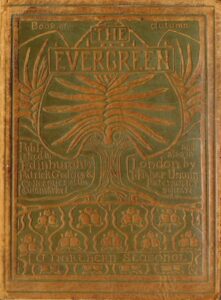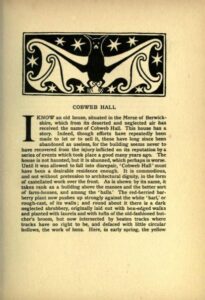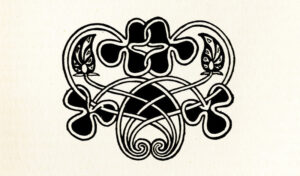“Cobweb Hall” As A Celtic Short Story
© Copyright 2019 Emma Holborn, Ryerson University
Introduction
The work I will be analysing is “Cobweb Hall: A Berwickshire Folk-Tale” by George Douglas.

“Cobweb Hall” was published in the Autumn edition of The Evergreen: A Northern Seasonal in 1895. I will be addressing how Douglas used a combination of old and new genres in “Cobweb Hall” as both an example of Celtic literature, an ancient genre, as well as of a Victorian short story, a genre which was just being pioneered around the time that “Cobweb Hall” was published to create the story of “Cobweb Hall”.
George Douglas and the Evergreen
The Evergreen was a Celtic Revival magazine that was published in Edinburgh by Patrick Geddes and his colleagues. (Kooistra) Multiple re-told folktales were published in The Evergreen, one of which being “Cobweb Hall”. The piece is the only work in this issue of the magazine that was written by George Douglas. Douglas used to be known as George Douglas Brown, his full name, but shortened his name to hide that he was the author of The House with the Green Shutters, a very popular novel at the time. (Cevasco 79) “Cobweb Hall” is placed in the second section of the magazine, entitled “Autumn in Life”. The story coincides with the theme of that section, which is “individual death”. (Kooistra)
The Plot of “Cobweb Hall”
“Cobweb Hall” is a scary story of sorts. The plot revolves around the story’s namesake: a house out in the Scottish

countryside nicknamed “Cobweb Hall” because of its dilapidated state. The narrator starts out by explaining the house’s current state with detailed description comparing it to how it used to look in its former glory and then flashes back in time to explain why the house hasn’t been occupied in many years. In the time of Cobweb Hall’s occupancy, everyone living in the town nearby always told the owner of the house, an elderly lady named Miss Clinkscales, that she should move out of the countryside and into the town. The townspeople would tell her that it’s not safe for her out there, especially since she hides away all her money somewhere in her home instead of at the bank. Miss Clinkscales doesn’t listen to them as she thinks the townspeople are just waiting for her to die so they can inherit her assets.
One day Miss Clinkscales is found violently murdered in her home with her riches stolen from the cupboard in her bedroom. The butler of the house goes missing around the time of the murder, so he is the primary suspect. An investigation by the police is conducted to discover the culprit but the police are unable to find the murderer. The summer fades into autumn with no hints as to where the murderer could be. Miss Clinkscales’s butler is eventually found many months later hiding in the nearby farm field, discovered because his hideaway in the field was being ploughed for the harvest. The butler hid in the field because he had broken his leg jumping out the window to flee the scene of the crime. The butler was not able to go any further than the field and he had to rely on eating the crops being grown in the field to survive until he was caught. After his discovery, the butler writes a letter attempting to absolve himself from blame, but he is found guilty regardless and is hanged for his crimes. “Cobweb Hall” ends with the narrator explaining that this story is why no one has lived in Cobweb Hall to this day. The story is based on an old folktale that used to be told in the Berwickshire area of Scotland.
Celtic Literature
Celtic literature is often known for its use of melancholy as a theme in its narratives. The genre is also known for detailed descriptions of nature and its beauty and may sometimes include fantastical or supernatural aspects like fairies and other mythical creatures or strange, unexplainable events. “Cobweb Hall” would be considered an example of Celtic literature, mainly because of its themes of nature and melancholic theme of death. The story revolves around the death of a main character and includes ongoing themes and descriptions of nature. The plot point involving the discovery of the murderer of Miss Clinkscales revolves around nature, specifically the change of seasons, the murderer was only discovered because of the change of seasons from summer to fall and the resulting harvest.
There are no explicit fantastical elements that coincide with themes of Celtic literature in “Cobweb Hall”, but the supernatural is hinted at. At one point after the murder, a servant of Miss Clinkscales sees the butler right in front of her in the shrubbery as if he appeared from no where out of the ground. The servant runs inside, and two men go out looking for him only to find nothing and the butler had disappeared again. Upon reading this story for the first time this event seems to be a supernatural occurrence or some kind of hallucination by the servant but later it is revealed that the butler emerged from the field to get near the house to try to steal food from the farm animals and ran into the servant on his way.
At the beginning of “Cobweb Hall” there are elegant descriptions of nature like: “The red-berried bar-berry plant now pushes up strongly against the white ‘harl,’…there is a dark neglected shrubbery, originally laid out with box-edged walks and planted with laurels and with tufts of the old-fashioned but-cher’s broom…the yellow aconite flourishes, in the shade under the trees.”(Douglas 43-4) These descriptions of the nature surrounding the house draw attention to the contrast between what Cobweb Hall looks like as an abandoned house and what it used to look like when it was inhabited.
An example of the melancholic themes that are common in Celtic literature within “Cobweb Hall” is that the entire story revolves around an eternally empty, previously nice house that was tainted by a murder which resulted in the house’s continued inoccupancy. As Kooistra said, pieces in the “Autumn in Life” section of this edition of The Evergreen share themes of individual death, with death being an example of a melancholic theme. A second example of melancholic themes in “Cobweb Hall” is within the title itself. The title of the story is eponymous with the nickname given to the old house. The narrator never reveals the real name of the house but instead shares the name given to it by those who have witnessed the house in its current disrepair, which in itself gives off melancholy because the house is abandoned, and it is sad that the actual name of the house doesn’t matter anymore.

The end piece image published after “Cobweb Hall” is also in the Celtic style. The end piece is an illustration of
four interwoven clovers with two leaves on either side. The Celtic natural themes are demonstrated through the clovers and leaves. The woven clover stems are similar to a Celtic knot which is a design in a complicated pattern that appears to have no beginning or end, as a never ending loop. In Celtic culture these represent eternity, love, loyalty, friendship and/or faith. This illustration fits in with the overall theme of Celtic Revival in The Evergreen.
The Victorian Short Story
Short stories were originally known as Victorian short stories until the term was eventually shortened to just short stories. The beginning of short stories was quite a transitional period as the typical Victorian literature before short stories was a multi-volume novel, so Victorians were used to reading literature significantly longer than short stories. (Margree) An important aspect of the rise of short stories is that in the nineteenth-century printing prices were made considerably lower than previously because of advancing technologies, resulting in a rise in the number of periodical magazines being published. The rising popularity of periodical magazines around the time of 1830 created a place for short stories to flourish. (Lewis 2) “Cobweb Hall’s” publication in The Evergreen was an example of this and helped to increase the popularity of short stories.
The short story is notoriously difficult to define but Edgar Allan Poe described short stories as works that can provide a “unity of effect or impression”. (Thorne-Murphy) Poe says a short story can be read all at once and elicit a complete effect on the reader as they read the whole story at once. A novel could not create this unity as it is broken up by multiple sittings of reading. In short, this definition means that a short story is one that can be read in one sitting, with Poe suggesting this should take ‘from a half-hour to one or two hours in its perusal’ (Maunder 3). Reading a story all at once lays this unique effect on the reader as they can notice elements like details in the story and connections between plot points that may not have been noticed if the story were in the longer form of a novel. The short story form also allows for the reader to be more immersed in the plot of the story as they don’t have to stop reading until the story is finished. Since this definition of a short story holds just one requirement, which is the ability to easily read the story in its entirety at one time, “Cobweb Hall” by this definition is a short story.
“Cobweb Hall” As A Celtic Short Story
This exhibit demonstrates how stories like “Cobweb Hall” and its publication in The Evergreen helped to create the short story as a genre and how in this example and others as well, short stories were created with the influence of other, older and sometimes ancient genres. “Cobweb Hall” has been proved to be a work of Celtic literature, being based off of a Berwickshire folktale that Douglas adapted into a written story. This conversion of the story from a spoken folktale told around its county of origin to a written narrative that can be read in many other parts of the world is what combines the genres of Celtic literature and short story. “Cobweb Hall” was published in one of the magazines that made the emerging genre of short stories popular, resulting in the creation of a brand-new genre that has roots in an old one as well as provides access to stories that without the written word, would be contained in their small area of origin.
Conclusion
“Cobweb Hall” demonstrates the origin of the short story genre and its roots in older genres like Celtic literature by including plot points and themes of nature as well as melancholic themes in the narrative. This melding of genres helped to transform folktales into literature and spread the stories from their place of origin to other parts of the world for others to enjoy. Douglas’s “Cobweb Hall” shows that recycling old forms can lead to the creation of new things, like the short story genre.
Works Cited
Cevasco, George A. The 1890s: An Encyclopedia of British Literature, Art and Culture.
Garland, 1993.
“The Contents.” The Evergreen: A Northern Seasonal, vol. 2, Autumn 1895, pp. 6-7. Yellow
Nineties 2.0, edited by Lorraine Janzen Kooistra, Ryerson University Centre for Digital Humanities, 2018. [url]
Douglas, Sir George. “Cobweb Hall.” The Evergreen: A Northern Seasonal, vol. 2, Autumn
1895, pp. 43-55. Yellow Nineties 2.0, edited by Lorraine Janzen Kooistra, Ryerson
University Centre for Digital Humanities, 2018. [url]
Headpiece for “Cobweb Hall.” The Evergreen: A Northern Seasonal, vol. 2, Autumn 1895, p. 43.
Yellow Nineties 2.0, edited by Lorraine Janzen Kooistra, Ryerson University Centre for
Digital Humanities, 2018. [url]
Kooistra, Lorraine Janzen. “Critical Introduction to The Evergreen: A Northern Seasonal,
Volume 2: Fall 1895.” Evergreen Digital Edition, Yellow Nineties 2.0 , Ryerson
University Centre for Digital Humanities, 2019. http://1890s.ca/egv2_introduction/
Kooistra, Lorraine Janzen. “General Introduction to The Evergreen: A Northern Seasonal,
Evergreen Digital Edition, Yellow Nineties 2.0 , Ryerson University Centre for Digital Humanities, 2019. http://1890s.ca/the_evergreen_general_introduction/
Margree, Victoria. “The Victorian Short Story Forum: An Introduction.” Victorian
Review, vol. 44 no. 2, 2018, p. 163-166. Project MUSE, doi:10.1353/vcr.2019.0019.
Maunder, Andrew, et al. The British Short Story, Palgrave Macmillan,
2010.ProQuestEbookCentral,https://ebookcentral-proquest-com.ezproxy.lib.ryerson
.ca/lib/ryerson/detail.action?docID=4007836.
Tailpiece for “Cobweb Hall.” The Evergreen: A Northern Seasonal, vol. 2, Autumn 1895, p. 55.
Yellow Nineties 2.0, edited by Lorraine Janzen Kooistra, Ryerson University Centre for
Digital Humanities, 2018. [url]
Thorne-Murphy, Leslee. “Introduction to Victorian Short Fiction.” Victorian Short Fiction
Project – Introduction to Victorian Short Fiction, Brigham Young University – Idaho, vsfp.byu.edu/index.php/victorian-short-fiction-project/about-victorian-short-fiction/
